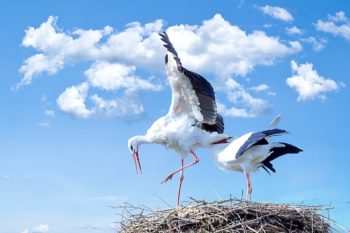Storks in Poland Posted by Kasia on Jul 13, 2012 in Places to visit
Did you know that every fourth stork (bocian) is Polish?
Each spring, Poland welcomes home roughly 25 percent of the nearly 325,000 white storks (scientific name Ciconia ciconia) that breed in Europe. When the storks return from their wintering grounds in Africa, they are attracted to tall trees or buildings where they build nests. People in Poland sometimes attach wagon wheels to rooftops and barns or tall poles near buildings in hopes of luring the birds to nest near their homes. Today, telecommunications companies put up special poles and nest supports for the storks.

Image by Michael Schwarzenberger from Pixabay
Adult white storks are about 1 m (3 ft) tall, with long red legs, a straight pointed red bill, white plumage, and black wing feathers.They eat a wide variety of prey items including insects, frogs, toads, fish, rodents, snakes, lizards, earthworms, and other prey found on the ground.
Storks are considered to be silent birds, but white storks throw their heads back and clatter their upper and lower bills together rapidly, making a loud rattle.
The map on the left shows the average number of stork pairs per square km in each of the 16 provinces of Poland, with the greatest density in the east and northeastern areas. Nearly 41 thousand “couples” of the 160 thousand worldwide breed in Poland, thus, “every fourth stork is Polish.”
Stork nests are huge: some old nests may be over 6 ft (2 m) in diameter and nearly 9 ft (3 m) in depth. They are constructed of branches and sticks and lined with twigs, grasses, sod, rags, and paper. Some nests have been in continuous use for hundreds of years . Breeding birds add to the nest each summer, with both males and females contributing to the construction.
Storks stay with one mate for the breeding season, but they do not migrate or over-winter together. If the same pair mates the next year, it is because of a strong attachment to the nesting site. The female usually lays 3–5 eggs, and both parents incubate the eggs for about one month. Young chicks are covered with white down and have black bills; their legs and bills slowly turn red as they mature.
Both parents bring food to the nest until the young fledge at 8–9 weeks of age. As the babies prepare for their first flight, they practice by jumping up from the ground floor of the nest, and then take small flights near the nest.Before the summer is over, they join their parents at the feeding grounds, which are usually near wet or marshy areas. Young birds reach sexual maturity when they are four years old, and can live and reproduce for over 30 years.
The overall population of white storks in western Europe has declined steadily over the past century, largely due to pollution and loss of habitat. For example, 4000 pairs made their home in Denmark in 1890, but only 12 pairs were recorded in 1989. Although storks are protected by popular opinion in Europe, they are persecuted in other areas, such as Africa, where they overwinter. Recently, storks that usually migrate to Africa for the winter have been observed to stop in Spain, near the large refuse areas near Madrid, where they find sufficient food.
Today, conservationists use webcams watch over and monitor the process of nesting and raising the youngfrom the first arrival of potential parents in late March or early April to the departure of the family in late summer (September). They are joined by others who love the storks and want to see them flourish. You can watch nesting birds at Polish Stork Webcam.
stork – bocian
red bill – czerwony dziób
white plumage – białe upierzenie
nest – gniazdo
mate – towarzysz, partner
breeding season – sezon rozrodczy, lęgowy
wagon wheels – koła wagonów
telephone poles – słupy telefoniczne
to migrate – migrować
roof – dach
habitat – środowisko
Do następnego razu… (Till next time…)

Build vocabulary, practice pronunciation, and more with Transparent Language Online. Available anytime, anywhere, on any device.
About the Author: Kasia
My name is Kasia Scontsas. I grew near Lublin, Poland and moved to Warsaw to study International Business. I have passion for languages: any languages! Currently I live in New Hampshire. I enjoy skiing, kayaking, biking and paddle boarding. My husband speaks a little Polish, but our daughters are fluent in it! I wanted to make sure that they can communicate with their Polish relatives in our native language. Teaching them Polish since they were born was the best thing I could have given them! I have been writing about learning Polish language and culture for Transparent Language’s Polish Blog since 2010.



